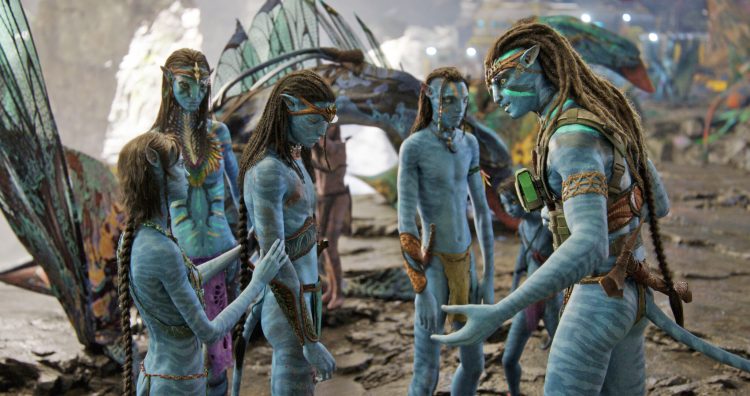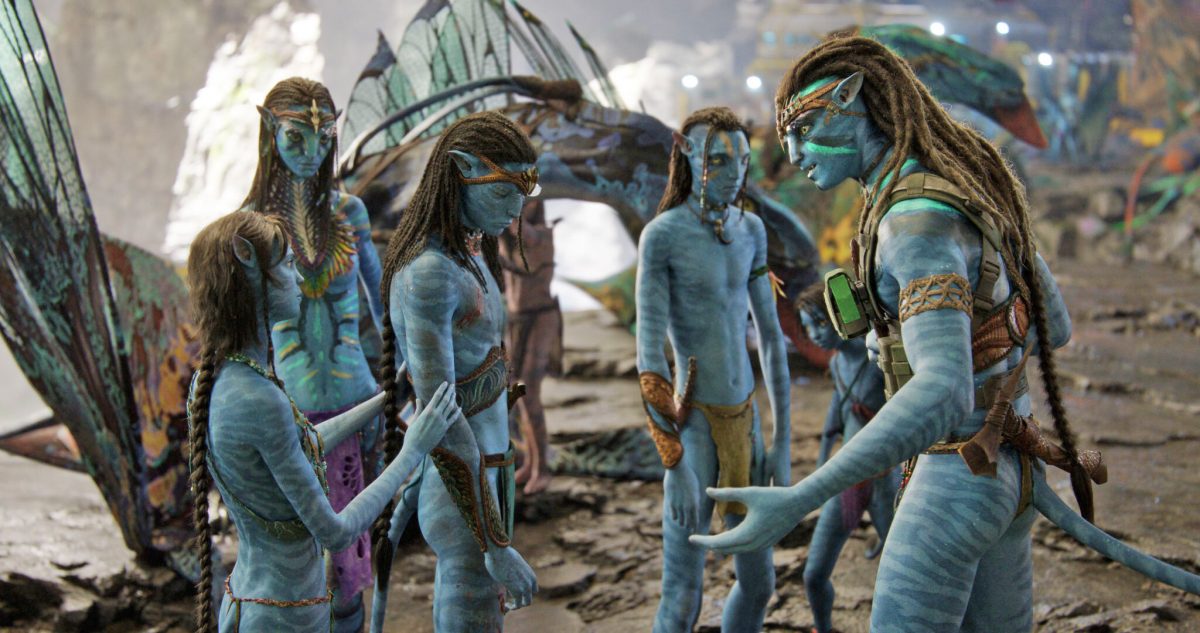The sequel to 2009’s megahit “Avatar”, this one subtitled “The Way of Water”, arrives in cinemas to a markedly different world than its predecessor. Things have changed so much in the film industry. Even more than the fact that the first film preceded the behemoth domination of Marvel Cinematic Universe, things have changed for what cinema means. Between the pandemic’s effect on popular cinema, the ascendancy of streaming and the changing trends of film premieres, “The Way of the Water” feels both like something refreshingly new but also something familiarly old.

It is there in the shape of the film. This is a three-hour and seventeen-minute epic, which takes its time bringing us back to the Pandoran biosphere and turning the straight-forward two-person focus of the original film into something more dynamic. This new “Avatar” is not a continuation of Jake and Neytiri’s story; it is a film about family. It is the story of the Sully family leaving their forests when Sky People return to Pandora with a vengeance to find Jake – the human who betrayed his own. It is also a story of the Metkayina, reef people, who live very differently from the Omaticaya forests. The family’s journey to the free-diving people turns “The Way of Water” into something very different spatially and visually. There is so much at work here; there is so much to see, a great deal of it different and new. And yet, the links to that first film feel indelible. An important mark of this is the commitment to the ideology of the Na’Vi people – “I see you” – which features in two key sequences of different dynamics. When the first film came out, even fans were diffident about phrase. But, in “The Way of Water” it takes on meaning in a way that feels like an important signpost of maturity.
What comes before the act of sight? Only darkness.
When Cameron was interviewed earlier in the year by New York Times, he mentioned the importance of the heroes from the 2009 growing older. His casual dig at the MCU, where the heroes never grow into adults, was seen as sour grapes and yet it’s a thought I kept in mind throughout “The Way of Water,” where the weight and responsibility of adulthood hangs over every frame. Cameron has always been preoccupied with dynamics of heritage and parents – their presence and their absence. In “The Way of the Water,” domesticity pointing to a maturity feels like a key to the importance of growing up and in it the gentle calm of the film’s own interest in the act of seeing as something sacred.
In the 2009 film when Jake Sully and Neytiri first exchange the line, I see you line” felt like a stand-in for “I love you”. In many ways, that first Avatar is a love story but when I saw the rerelease of the original film in October, 13 years older, the line felt different. Remember sincerity? Unceasing earnestness that believes in the make believe of its stakes without a hint of irony? There are jokes, yes. James Cameron is consummate dad-jokester. But this film believes in itself completely. There are few insults as casually cutting and as a dismissive as “taking oneself too seriously” or trying too hard. It’s seen in the way blockbuster cinema undercuts its emotional core at every turn for a good quip. But Avatar, and this new entry, resists that notion. And suddenly that “I see you” line feels like the clearest show of open sincerity. What other major blockbuster dares to hinge itself on something as straightforward and earnest as “I see you”?
In “The Way of Water” seeing is sacrosanct. That the pivotal ‘I see you’ moment of the first “Avatar” hinged on the romance between Jake and Neytiri seemed to eclipse that seeing was more than a romantic gesture. Instead it was something more seismic, even preternatural. It’s why, “I see” in English has become an idiom meaning more than just sight. To see is to understand, and it is to this recognition that Cameron is so committed. But seeing, in its inherent state, is passive. There is no compulsion of response in the thing that is considered. It exists as it is. Invited in to observe and perceive what exists, the seer can say yes, I do see. I understand. And it is that very stillness, even amidst the action-packed core of “The Way of Water”, that announces Cameron at his most sincere but also at his most adult. Even as children envelope the screen, “The Way of Water” feels mature and learned.
The film opens with a prologue as Jake’s narration takes us through the time lost since we last saw them. Neytiri has borne three children. The family is also joined by two adoptive children – Kira, a miracle child born out of the inert Na’Vi Avatar of Sigourney Weaver’s Grace Austine from film one (she returns to voice the teenage Kira) and a human boy Spider, who was too young to return to earth in cryostasis and now lives among the Na’Vi. In a moment in the prologue the family poses for a picture. When the picture is developed, they seem less eclectic. It’s a bit of gentle teasing from Cameron, the alien family being a picture of human domesticity posing for a picture, but I felt that the frisson between what we see of the family in the photograph and how we see them in real life movements feels integral to the meanings of reverberations of seeing. Every adult finger in the film emerges as a quasi-parental figure transforming “The Way of Water” into a tale of legacies, good and bad. The human dialogue sound robotic and mechanical, in a deliberate contrast to the earnest lyricism of the Na’Vi people. Dialogue may not emerge as Cameron’s best asset, but the script (cowritten with Rick Jaffa and Amanda Silver) has a thrilling sense of structure and momentum. The swerve into the final act is merciful. And in its kinetic energy, “Avatar” feels like the work of a filmmaker stretching imagination to its limits. It is a joy to watch.
But do they see? Cameron’s anti-imperialist message in the first “Avatar” found itself read against tales of ethnic miscegenation. But do people see “Avatar” for what it is? I don’t think so. And it’s easy to conflate it through our human prism of races. But it is imperative that “Avatar” not be understood as allegorical. Cameron’s work, like any work loaded with symbolism and motif, has always been read that way but to read Cameron as an allegory maker misses the very fact that Cameron’s vision is explicitly and deliberately otherworldly. “Avatar” is misunderstood when read through the prism of race. Its focus is unsubtly open. It is about the battle between humans and the unknown. In another world, menacing aliens invade earth as their planet dies. They are presented as cold and distant, and the humans are the good guys because who else but humans have the empathy and feelings? But, in “The Way of Water” the biggest threat to empathy in the universe are humans. Early in the film the mercenaries commit to moving to Pandora to save humanity. And what a humanity.
Humans in “Avatar” are inherently compromised, poisoned by the earth they are fleeing from. Bad-faith arguments viewing “Avatar” only through a reading buit on ethnic essentialism are just ineffective but counterintuitive. One way the “The Way of Water” amends its predecessor is in emphasising that the Na’Vi not be read as people of colour fighting against white hegemony. Cameron asks us to see beyond our human race wars and to recognise something more – a speciestic one. So, the Na’Vi are white (like Sam Worthington and Kate Winslet). They are Afro-Latinas like (like Zoe Saldana’s excellent work as Neytiri). They are Indigenous (like Cliff Curtis’s calm and steady Tonowari, the leader of the reef people). They are mixed-race like Filip Geljo (of Filipino-Bosnian heritage) or Bailey Bass (of Belarussian-African heritage.) It is not a battle of human ethnicities, or ought not be, but a battle of inherently different species so when the humans adopt the form of Na’Vis as a way of exterminating them it is more than a change of colour; the transformation changes their entire structure of being, even when the humans do not realise.
In “The Way of Water” Cameron seems to be joyously beckoning for us to step into his mind and into a new world, one that is antithetical to our earth. This is best realised in Kira, and it makes sense that is the role of Weaver – Cameron’s long-time collaborator. When she does her first dive, incandescent with awe at the possibilities under water, this feels like the closest stand-in for Cameron and also the most indelible link to the idea of seeing REALLY seeing. In so many moments, Kira sits on the edges of frame, silent but perceiving, silent but knowing, silent but seeing, really seeing. So her connection to the Tree of Souls, where she connects to receive visions of her biological mother is part of an important motif of visions in the film. These are visions that become complex once the characters allow themselves to be seen and to see in return.
When the film hurtles into its final hour (which feels so much shorter than the other two), Cameron’s technical aptitude emerges. And we see traces of film history. A bit of “Jaws”, a bit of his own “Titanic”, a bit of every adventure movie but “The Way of Avatar” is empathically its own thing. It has to be. Its very centre is built on a rejection of the familiar. But to see “Avatar,” to really see it requires a sense of trust, a sense of openness that might not resonate with everyone. But, to see someone, really see someone, is to perform an act of commitment. Truly seeing depends trust. And to open yourself up to “The Way of Water”, in the same way the Sully family must open themselves up to the ways of their new water home, means an abandonment of expectations that might not work for some. But in the film’s closing moment, punctuated by a moment of two characters seeing their own vision connected to the mother tree, those eyes – tearful ones this time – see something that they are yearning to. This family is our fortress, Jake tells his family early on. When he repeats it towards the end, though, he has a deeper understanding of what that means. He too must abandon ego to see them, really see them, for what they are. And it is that realisation that makes even the elegiac tone of the ending feel warm and hopeful. It is a level of sweet kindness that feels new even for James Cameron.
Don’t we all want to be seen or understood? Every fibre of “Avatar” feels committed to that. This new world of “The Way of Water” beckons with its sincerity. And in that sincerity, it is one of the best films of the year.

